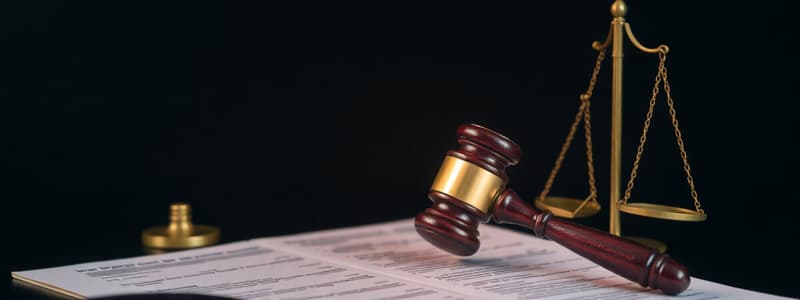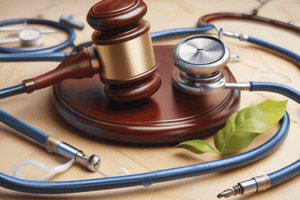Podcast
Questions and Answers
Which form of business organization is specialized for utilizing a firm's business model and name?
Which form of business organization is specialized for utilizing a firm's business model and name?
- Sole proprietorship
- Corporation
- Partnership
- Franchise (correct)
What legal concept relates directly to the ownership and protection of creations like inventions and brands?
What legal concept relates directly to the ownership and protection of creations like inventions and brands?
- Personnel law
- Intellectual property law (correct)
- Tax law
- Bankruptcy law
Which of the following legal concepts is NOT classified under the inception of an entrepreneurial venture?
Which of the following legal concepts is NOT classified under the inception of an entrepreneurial venture?
- Copyrights
- Hiring and firing policies (correct)
- Trademarks
- Patents
Which component is crucial for the ongoing venture in terms of legal considerations?
Which component is crucial for the ongoing venture in terms of legal considerations?
What segment of law deals with the condition under which businesses can legally operate?
What segment of law deals with the condition under which businesses can legally operate?
When considering the growth of an entrepreneurial venture, which tax consideration must entrepreneurs be aware of?
When considering the growth of an entrepreneurial venture, which tax consideration must entrepreneurs be aware of?
Which of the following is an example of collective bargaining?
Which of the following is an example of collective bargaining?
Which legal concept focuses on the guidelines for creating valid sales contracts within a business context?
Which legal concept focuses on the guidelines for creating valid sales contracts within a business context?
What is the duration of design patents?
What is the duration of design patents?
Which of the following is NOT a component of a patent application?
Which of the following is NOT a component of a patent application?
What does the specification of a patent application usually include?
What does the specification of a patent application usually include?
How are claims defined in a patent?
How are claims defined in a patent?
Which statement about patents is accurate?
Which statement about patents is accurate?
What is the process of obtaining a patent from application to allowance?
What is the process of obtaining a patent from application to allowance?
What does the 'claim for a pencil' specifically outline?
What does the 'claim for a pencil' specifically outline?
What unique aspect must be proven in the patent application process?
What unique aspect must be proven in the patent application process?
What should a patent pursuit focus on to be effective?
What should a patent pursuit focus on to be effective?
What is essential to include in the patent plan?
What is essential to include in the patent plan?
Why is it important to relate actions to the original patent plan?
Why is it important to relate actions to the original patent plan?
What is the purpose of establishing an infringement budget?
What is the purpose of establishing an infringement budget?
What strategic evaluation should be made about the patent plan?
What strategic evaluation should be made about the patent plan?
What do patents confer upon inventors?
What do patents confer upon inventors?
Which type of patent covers new and useful processes or machines?
Which type of patent covers new and useful processes or machines?
What is the duration of protection for a Design Patent?
What is the duration of protection for a Design Patent?
What is the initial period for which a trademark registration is valid?
What is the initial period for which a trademark registration is valid?
Which of the following is NOT a way a trademark may be invalidated?
Which of the following is NOT a way a trademark may be invalidated?
What is recommended when selecting a corporate name or trademark?
What is recommended when selecting a corporate name or trademark?
How often can a trademark be renewed after its initial registration?
How often can a trademark be renewed after its initial registration?
What type of name or mark is recommended to avoid when establishing a trademark?
What type of name or mark is recommended to avoid when establishing a trademark?
Under what circumstance can a trademark become generic?
Under what circumstance can a trademark become generic?
Which of the following is a potential pitfall when choosing a trademark?
Which of the following is a potential pitfall when choosing a trademark?
What can happen if a trademark is nonused for two consecutive years?
What can happen if a trademark is nonused for two consecutive years?
What is required to protect the name and logo of a new invention?
What is required to protect the name and logo of a new invention?
Which of the following is NOT considered a trade secret?
Which of the following is NOT considered a trade secret?
What does Chapter 13 bankruptcy primarily involve?
What does Chapter 13 bankruptcy primarily involve?
What is a characteristic of unsecured debts?
What is a characteristic of unsecured debts?
Which chapter of bankruptcy allows the debtor to formulate a plan to repay debts?
Which chapter of bankruptcy allows the debtor to formulate a plan to repay debts?
What is a primary goal of the Bankruptcy Act?
What is a primary goal of the Bankruptcy Act?
Which of the following is an example of a secured debt?
Which of the following is an example of a secured debt?
What may lead a company to bankruptcy according to the principles outlined?
What may lead a company to bankruptcy according to the principles outlined?
Which of the following is true regarding straight bankruptcy?
Which of the following is true regarding straight bankruptcy?
Which type of bankruptcy is referred to as reorganization?
Which type of bankruptcy is referred to as reorganization?
Study Notes
Chapter Objectives
- Highlight the significance of legal issues for entrepreneurs.
- Explore patent protection, including preparation and definitions.
- Review the relevance of copyrights for entrepreneurs.
- Study trademarks and their effects on new ventures.
- Present major bankruptcy law segments applicable to businesses.
Legal Concepts Overview
- Legal concepts categorized into three phases:
- Starting: Inception of the venture.
- Ongoing: Development and transactions during operation.
- Growth: Continuity and expansion of the venture.
Inception (Starting) of an Entrepreneurial Venture
- Intellectual Property Laws: Essential for protecting innovations.
- Patents: Exclusive rights for inventions.
- Copyrights: Protection for original works.
- Trademarks: Brand identification protection.
- Forms of Business Organization:
- Sole proprietorship, partnership, corporation, franchise.
- Tax Considerations: Important from the outset.
- Capital Formation: Essential for venture setup including equipment and property.
Ongoing Venture: Business Development and Transactions
- Personnel Law:
- Hiring and firing policies.
- Compliance with Equal Employment Opportunity regulations.
- Collective bargaining agreements.
- Contract Law:
- Importance of legal contracts, sales contracts, and leases.
Growth and Continuity of an Entrepreneurial Venture
- Tax Considerations: Federal, state, local taxes, and payroll.
- Government Regulations:
- Zoning laws and adherence to administrative agency guidelines.
- Consumer protection laws.
- Continuity of Ownership Rights:
- Property ownership laws.
- Legal documents such as wills and trusts.
- Bankruptcy considerations.
Patents
- Provide exclusive rights to produce, sell, or license a product or process.
- Types of Patents:
- Utility Patents: Last for 20 years, cover useful processes and machines.
- Design Patents: Last for 14 years, protect ornamental designs.
- Plant Patents: For distinct plant varieties, obtained through asexual reproduction.
- Patent application comprises two essential parts:
- Specification: Text detailing invention and its utility.
- Claims: Specific features of the invention defined for protection.
Securing a Patent: Basic Rules
- Pursue patents that are commercially significant.
- Prepare a detailed patent plan covering development and marketing costs.
- Maintain consistency with the original patent plan.
- Budget for potential infringement actions.
- Determine the strategic value of patents, considering the lengthy patent process.
Copyrights
- Protect original works of authorship such as literature and art.
- © symbol indicates copyright ownership.
Trademarks
- Distinctive symbols or names associated with a business.
- Registered trademarks are valid for 10 years with renewal options.
- Trademark validity may be challenged via:
- Distinctiveness claims.
- Nonuse or abandonment after two years without justification.
Trade Secrets
- Non-patentable business information that provides a competitive edge.
- Examples include customer lists and pricing strategies.
Bankruptcy
- Occurs when a business cannot meet financial obligations.
- Can result from market competition, lack of innovation, or excess inventory.
- Bankruptcy Act: Outlines procedures for handling insolvent debtors and protecting both debtors and creditors.
Types of Bankruptcy
- Chapter 7: Involves liquidation of assets to pay creditors.
- Chapter 11: Reorganization allows businesses to develop a plan to repay some debts while continuing operations.
- Chapter 13: Available for individuals with specific debt limits, offering debt adjustment options allowing for extended repayment.
Secured vs. Unsecured Debts
- Secured Debts: Tied to collateral, e.g., mortgages.
- Unsecured Debts: Not backed by specific assets, increasing risk for lenders.
Studying That Suits You
Use AI to generate personalized quizzes and flashcards to suit your learning preferences.
Description
This quiz explores Chapter 5 of the Entrepreneurship course, focusing on crucial legal issues faced by entrepreneurs. It covers patent protection, copyrights, trademarks, and relevant aspects of bankruptcy law. Test your understanding of these legal topics and their importance in the business world.



